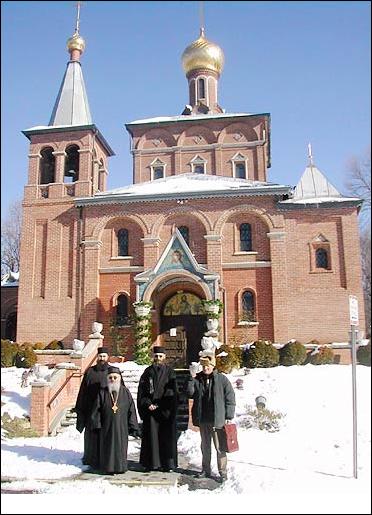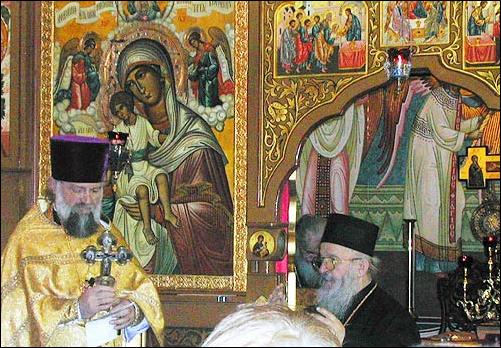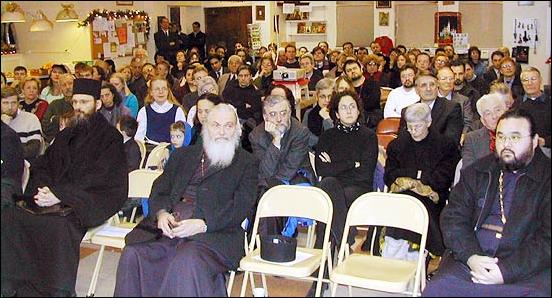NEWS
FROM THE DIOCESES |
| EASTERN AMERICAN DIOCESE: February 7, 2004 |
|
"CRUCIFIED
KOSOVO"
A reception was held on Monday evening, 2 February, 2004, in the
Parish Hall of the Cathedral of St. John the Baptist in Washington
DC, for His Grace the Most-reverend Artemije, Bishop of Raska and
Prizren, of the Serbian Orthodox Church. Addressing an audience
that filled the hall to overflowing, His Grace told of the current
state of the Orthodox Church in Kosovo and Metohija. Accompanying
Vladyka were his secretary, Hieromonk Symeon, and Abbot Vasily,
Father Superior of the Sopocani Monastery. The day before his talk,
Vladyka attended and prayed at the Divine Liturgy in the Cathedral
of St. John the Baptist. At the conclusion of the service, he greeted
the faithful, bestowing upon each his hierarchical blessing and,
as a memento, giving each person a little icon of St. Savva.
The Washington talk had first been presented on January 21, 2004,
in Moscow at the opening of the 14th Annual Conference of the Orthodox
St. Tikhonís Theological Institute. Bishop Artemije began by saying:
“Kosovo was crucified, and five years later it still hangs upon
the cross. The profound respect for the crucified victim forces
everyone to remain silent in front of the cross. Even the Mother
of God kept silent in front of her Sonís Cross, but tears never
ceased to speak.
“As the Orthodox bishop of Kosovo and Metohija I do not merely stand
in front of the cross of Kosovo crucified, I am myself crucified
on that same cross. That is why it is hard for me to speak about
it. And yet, I cannot keep silent, because I am called to speak.
If only I were granted the power of thunder or given a trumpet of
Jericho with which to make known and bear witness to what has been
happening in Kosovo and Metohija in the last five years!
“Kosovo and Metohija todayóand this word “today” covers the period
from 1999 to this day, and will continue beyond todayóresembles
more than anything else a Roman Coliseum of the early days of Christianity.
In it are present the torturers, the martyrs and the beasts, all
together, all at the same time. It is a blood-soaked place where
beasts devour innocent Christians while the spectatorsówhich in
this case is the whole worldówatch what is happening through mass
media and, in their enjoyment of the spectacle, are themselves transformed
into beasts. And there is no end to this gory orgy.
“In this tragedy, the Serbian people are cast in the role of the
victim. It is by Godís will that I am the spiritual leader of that
people. That is why I find it difficult to speak of my own suffering
and of the suffering of my people in cold, scientific, academic
terms. Feelings run high in a Coliseum. Of course, there are various
kinds of feelings, depending on the role one is asked to playóthe
role of the victim, the role of the beast or the role of the spectator
enjoying the performance…”
Bishop Artemije went on to describe the tragic fate of the Serbs
who remained in Kosovo, Serbs forced to live in enclaves reminiscent
of concentration camps. He also told of the desecration and destruction
of a multitude of Orthodox churches. Then Vladyka turned to the
numbers: He reported that during four and a half years in which
international peace-keeping forces have been in the land of Kosovo,
i.e. between June10, 1999 and the end of 2003, there were 6,392
attacks made against Serbs, resulting in 1,197 Serbs killed, 1,305
Serbs wounded, and 1,138 Serbs kidnapped. Today we know that 155
of the kidnapping victims were killed, 13 escaped, and 95 were released.
The fate of the remaining 863 Serbs is as yet unknown.
Following Bishop Artemijeís talk, Belgrade video journalist Lidya
Kujundjicís film "Crucified Kosovo," a film of staggering
emotional intensity, was shown. Ms. Kujundjic was in attendance
at its presentation in Washington. The film, which features chant
and other musical accompaniment, is an exceptionally graphic documentary.
It begins with a depiction of the great holy sites of Kosovo Ė Vysokij
Decani, Gracanica, Pec, Crna Reka, and others - that endured throughout
the 500 years of subjugation under the Ottoman yoke and throughout
the recent war. In the second part, we witness scenes of peaceful
church life in Kosovo and Metohije before the war of 1999. The concluding
portion of the film documents funerals of Serbs murdered by the
Muslims and the barbarous destruction of Orthodox holy places. The
film ends with a close-up of the sad and prayerful, ascetic face
of Hieromonk Khariton seen in profile; a tear slowly moves down
his left cheek. Abbot Vasilije of Sopocani Monastery, who was sitting
next to the author of these words, whispered “Fr. Khariton was martyred.”
Receiving this news made our impressions of the evening with Bishop
Artemije even more powerful.
The evening concluded with questions from the audience. In a series
of questions phrased in different ways, Vladyka Artemije was repeatedly
asked the single question: “What should the Serbs in Kosovo do?”
Vladyka responded: “We must pray and hope, we must patiently endure
and remain in our martyred Kosovo and Metohije, together with our
holy places, with the graves of our ancestors, and with firm assurance
that God also has the answer to this problem.” Protopriest
Victor Potapov |


